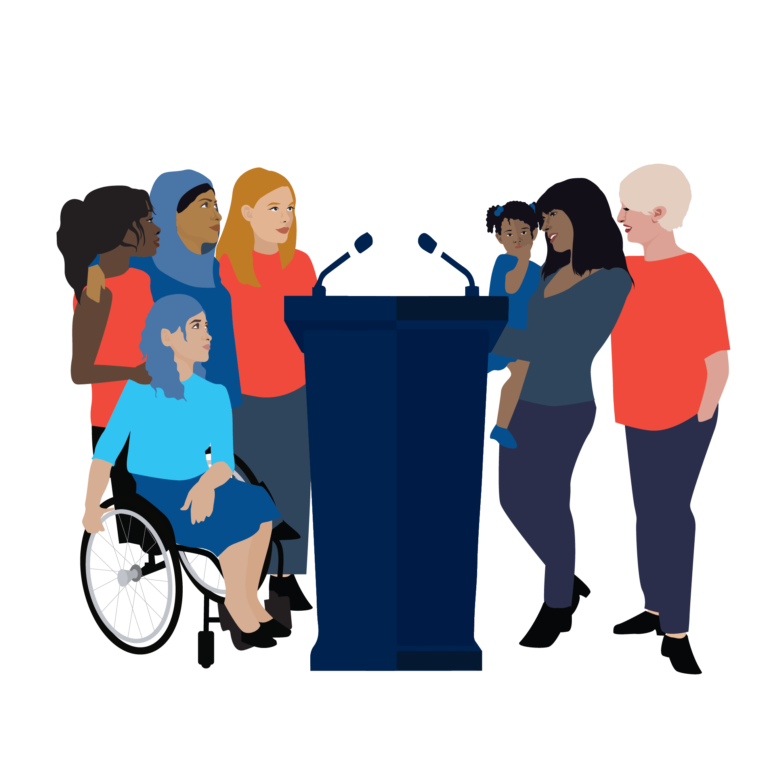Women in politics broke barriers this year—from Kamala Harris’s historic Vice-Presidential election to the record…
Are We There Yet?

The 2020 elections marked a turning point for women in politics and the media—from the historic election of Kamala Harris as Vice President to the record-breaking 141 women, including 51 women of color—elected to serve in Congress.
Yet challenges remain, both in terms of media coverage of women in politics—and the treatment and representation of female political journalists of color and overall. That’s why we have called our upcoming event “Are We There Yet? Progress and Challenges for Women in Politics and Media, 2020 and Beyond.” “Are We There Yet?”—that classic line from passengers on a long car trip—implies we’ve come a long way, and there’s a ways to go.
As noted in Politics and the Media: Intersections and New Directions, we are, in general, beyond the most sexist media depictions of women running for office from the past: a major focus on “hair, hemlines, and husbands” rather than proposed policies, although there’s still a lag in coverage. TV punditry from some of the most popular prime-time hosts continues to be a place where personal criticism of women including describing them as “strident”—and worse—remains. In publications, the remaining gender imbalance is seen when you substitute the name of a male candidate—his hair, his wardrobe, his family, and questions about who’s home taking care of the kids.
Despite considerable progress, in a study of some 1,400 news stories in major publications during 2019, the authors found that “female candidates were much more likely to be critiqued personally and negatively than their male counterparts,” while men received more attention to their policy proposals. The reason this is important? As we know from numerous studies, such coverage and commentary affect voters’ perceptions of women’s viability as candidates and their ability to lead.
The 2020 presidential primaries brought a field of Democratic candidates that were historically diverse, with a record six women running to be the first woman president of the U.S. The fact that the list included four U.S. Senators—Kirsten Gillibrand, Kamala Harris, Amy Klobuchar, and Elizabeth Warren—along with Hawaii representative and military veteran Tulsi Gabbard and author Marianne Williamson showed the results of having more women in the political pipeline for running for office.
There were also gains in 2020 by women in state legislative office. Republicans moved successfully to elect more Republican women to Congress. And the news media highlighted the role of Black voters and Black female leaders including Stacey Abrams as Biden considered potential vice-presidential candidates. Media coverage of Kamala Harris’s nomination and election focused on the historic “firsts” her election represented. All of these changes signify great progress. Now it’s time to see how Harris’s role is emerging, in policy and politics as well as media coverage.
There are several recent and upcoming elections where women are no longer running as the “first” and “only.” The barrier-breaking contest in the Boston mayoral race between City Councilor Michelle Wu and City Councilor Annissa Essaibi George is just one example. And yet the U.S. presidency remains a highly gendered space, in politics and in media coverage. When Elizabeth Warren, an early front-runner for the nomination in 2020, withdrew in a race that Democratic voters said hinged on “electability,” and who was widely considered the best bet to defeat Donald Trump, some Warren supporters and media critics wondered how and whether she had been hurt by comparisons to her as “another” Hillary Clinton. There were questions about whether Warren, with her seemingly Hillary-like experience and specific proposals, was “likeable” enough. There were also age-old questions raised about whether the U.S. was “ready” for a female president. As research from the Barbara Lee Family Foundation and others has shown, voters will vote for a male candidate they consider qualified but unlikeable, while being perceived as unlikeable hurts female candidates.
“The whole idea of ‘likeability,’” says Democratic strategist Celinda Lake, “has to do with deep-seated, ingrained attitudes about gender roles and women in positions of power.”
There are more women today covering politics, in a field that has been dominated for many years by older white men. The 2016, 2018, and 2020 elections and the Trump presidency, along with a divided electorate and tumultuous events including the death of George Floyd and a racial reckoning in this country, have put issues of race and gender front-and-center on the political and media agenda. Regrettably, misogyny and hate against both prominent female journalists and prominent female politicians also have multiplied online. Kamala Harris and other women of color have been especially targeted.
In our “Are We There Yet?” event, we’ll hear a first-hand perspective from veteran White House correspondent April Ryan about her experience asking tough questions of President Trump—and the continuing response. We’ll also talk about her career covering the White House and her views on women in politics and media overall.
Jane Hall is the author of Politics and the Media: Intersections and New Directions, published this fall by CQ/Sage Press. She is an associate professor in the School of Communication at American University.






